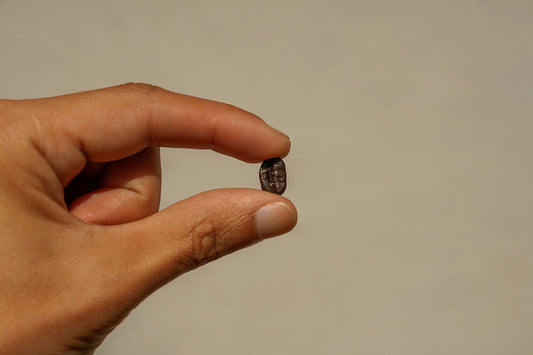For many avid coffee enthusiasts, the daily ritual of savoring a cup of coffee is a cherished routine. However, a looming concern within the community revolves around the potential connection between coffee consumption and acid reflux.
The question "Does coffee cause acid reflux?" echoes through the minds of health-conscious individuals who seek a balance between their love for this beloved beverage and the desire to maintain optimal well-being. In the pursuit of a healthier lifestyle, understanding the impact of coffee on digestive health becomes crucial.
This article delves into the intricacies of this often-debated topic, shedding light on the relationship between coffee and acid reflux, and aims to provide insights for those who value both their morning brew and their digestive comfort.
Whether you're a seasoned coffee connoisseur or someone exploring health and beverage choices, uncovering the dynamics of this connection may hold valuable insights for your daily routine.
/ IN THIS ARTICLE
01. Understanding Acid Reflux and Coffee's Role
02. How Coffee May Trigger Acid Reflux
03. Types of Coffee and Their Effects on Acid Reflux
04. The Role of Caffeine in Acid Reflux
05. Comparing Acid Levels in Different Coffees
06. Brewing Methods and Their Impact on Acidity
08. Dietary Habits and Coffee Consumption
09. Coffee Alternatives for Acid Reflux Sufferers
10. Lifestyle Changes to Mitigate Acid Reflux
11. Medical Perspective on Coffee and Acid Reflux
12. User Experiences: Coffee and Acid Reflux
13. Frequently Asked Questions
14. Conclusion
Understanding Acid Reflux and Coffee's Role
Acid reflux is a digestive problem when the acidic fluid in the stomach flows back up into the esophagus. In healthy conditions, you have a particular structure in your esophagus to avoid this fluid retention, which is the lower esophageal sphincter.
It is a valve-like muscle located right before the beginning of the stomach and prevents stomach acid from moving upward.
Sometimes this valve-like muscle doesn't stay fully closed. This causes a risk for stomach acid to go back up into the esophagus. Stomach acid is a solid acid to help food digestion.
Therefore, the stomach has a special mucus layer that protects the cells in the stomach from this acidic fluid. But naturally, the esophagus doesn't have any protection like the stomach.
So when this acid goes back into the esophagus, it may damage the esophagus wall. Therefore, it can lead to heartburn, a burning sensation in the chest, which is the most common symptom of acid reflux.
How Coffee May Trigger Acid Reflux
Coffee, a beverage beloved for its rich flavor and stimulating properties, contains components that can potentially trigger acid reflux. One key factor is the inherent acidity of coffee, with its pH level ranging from approximately 4 to 5.
The acidity may prompt an increase in stomach acid production, contributing to the likelihood of reflux. Additionally, coffee contains various compounds, such as catechols and N-alkanoyl-5-hydroxytryptamine, which can relax the lower esophageal sphincter.
This muscular valve normally acts as a barrier, preventing the backward flow of stomach acid into the esophagus. When relaxed, however, it becomes more permissive, allowing acid to reflux and cause discomfort.
Understanding these components sheds light on how coffee may be a potential trigger for acid reflux.
Individuals sensitive to these factors may consider lower-acid coffee options or explore alternative beverages to enjoy the flavor of coffee while minimizing the risk of exacerbating acid reflux symptoms.
Types of Coffee and Their Effects on Acid Reflux
- Regular Coffee (Highly Acidic): Regular coffee is known for its robust flavor, but it tends to be highly acidic, with a pH ranging from around 4 to 5. This acidity can stimulate increased stomach acid production and may contribute to acid reflux symptoms in susceptible individuals.
- Espresso (Concentrated Acidity): Espresso, a concentrated form of coffee, has a similar acidity to regular coffee. While the serving size is smaller, the concentrated nature might lead to a more pronounced impact on acid reflux for some individuals.
- Decaffeinated Coffee (Lower Acidity): Decaffeinated coffee is often considered a milder option for those concerned about acid reflux. While not entirely free of acidity, the decaffeination process typically reduces its acid content, making it a potentially gentler choice for individuals with sensitivity to high-acid beverages.
Considering these variations in acidity among different types of coffee is essential for individuals aiming to enjoy their coffee while minimizing the risk of acid reflux.
Personal tolerance levels can differ, so experimenting with various coffee options and observing individual responses can help identify the most suitable choice for a satisfying coffee experience without compromising digestive comfort.
The Role of Caffeine in Acid Reflux
Caffeine has been cautioned against by gastroesophageal reflux disease (GERD) surgeons as a potential symptom aggravating acid reflux. Your acid reflux symptoms may worsen if you drink coffee, soda, or certain types of tea, all of which contain caffeine.
The Lower Oesophageal Sphincter (LES) pressure can be reduced by caffeine.
The lower oesophageal sphincter (LES), which opens into the stomach, can relax after consuming coffee. The lower oesophageal sphincter (LES) opens to let food into the stomach after eating, but it closes to keep the acidic contents of the stomach from refluxing into the oesophagus.
One possible side effect of caffeine is acid reflux, as it has the ability to relax the LES. Reflux surgery may be recommended by your GERD surgeon in Macon to treat chronic acid reflux and prevent irreparable damage to the oesophagus.
Additionally, caffeine can increase gastric acid output.
Caffeine stimulates the formation of gastric acid, which can irritate the stomach. These stomach acids are more likely to reflux into the oesophagus when caffeine weakens the LES.
Seek the advice of a GERD expert if you are experiencing persistent acid reflux symptoms. Untreated acid reflux can cause Barrett's oesophagus and other significant health problems, including cancer.
While you wait, you can make some easy adjustments to your diet to reduce your risk of acid reflux, such as standing up straight after eating, avoiding fatty and spicy foods, and cutting back on coffee. Even though water is the most effective drink, some people still prefer flavoured drinks.
Comparing Acid Levels in Different Coffees
Coffee is a complex beverage with a wide range of flavors, and acidity is a crucial component that contributes to its taste profile. The acidity in coffee refers to a bright, tangy, or sharp sensation on the palate and should not be confused with pH levels.
Here's a brief overview of the acid levels in various coffee types:
Arabica vs. Robusta
- Arabica Coffee: Generally, Arabica beans have higher acidity compared to Robusta. The acidity in Arabica coffee is often described as bright, lively, and nuanced, with flavors that can include fruity, floral, or wine-like notes.
- Robusta Coffee: Robusta beans tend to have a lower acidity level and are often associated with a more earthy, woody, or nutty flavor profile. This type of coffee is known for its boldness and higher bitterness.
Growing Conditions
- Altitude: Coffee grown at higher altitudes often has higher acidity. The slower maturation of the beans at higher elevations contributes to a more complex flavor profile.
- Climate: The climate of the region, including temperature and rainfall, also influences acidity. Coffees from regions with distinct wet and dry seasons may exhibit more pronounced acidity.
Processing Methods
- Washed Process: Coffees processed using the washed method tend to have brighter acidity. This method involves removing the cherry pulp before drying the beans, resulting in cleaner flavors.
- Natural Process: Natural or dry-processed coffees can have lower acidity but offer a full-bodied, fruity, and sometimes fermented taste due to the extended contact between the bean and the fruit during drying.
Origin-Specific Characteristics
- Ethiopian Coffees: Ethiopian coffees, particularly Yirgacheffe, are known for their high acidity and vibrant, fruity notes.
- Latin American Coffees: Coffees from countries like Colombia and Costa Rica often exhibit a balanced acidity with citrusy and floral undertones.
- Indonesian Coffees: Sumatran coffees, for example, are low in acidity and feature earthy, spicy, and sometimes herbal notes.
Roast Levels
- Light Roasts: Lighter roasts tend to preserve the natural acidity of the beans, allowing the distinct origin flavors to shine.
- Medium and Dark Roasts: As you move towards medium and dark roasts, the acidity may decrease, and the coffee can develop more body and bitterness. However, this varies based on the bean's origin and quality.
The acidity in coffee is a multifaceted characteristic influenced by factors such as bean type, growing conditions, processing methods, and roast levels. Understanding these factors can help coffee enthusiasts choose a brew that aligns with their taste preferences.
Brewing Methods and Their Impact on Acidity
The acidity of coffee is a crucial aspect of its flavor profile, and various brewing methods can significantly influence this characteristic. Understanding how different techniques impact acidity is essential for coffee enthusiasts seeking to tailor their brew to personal preferences.
Grind Size and Extraction
- The grind size of coffee beans plays a pivotal role in determining acidity. Finer grinds generally lead to increased extraction, which can intensify acidity. Methods such as espresso, which utilize fine grinds and high-pressure extraction, often result in a more acidic cup compared to coarser methods like French press.
Brewing Temperature
- The temperature at which coffee is brewed can impact acidity. Higher temperatures tend to extract more acids from the beans, contributing to a brighter and more acidic flavor. Pour-over methods often involve precise temperature control, allowing users to manipulate acidity based on preference.
Brewing Time
- The duration of the brewing process is another crucial factor. Longer extraction times, as seen in methods like cold brew, can lead to a smoother and less acidic cup. Conversely, shorter brew times, as in espresso, may enhance acidity due to the rapid extraction of acids.
Water-to-Coffee Ratio
- Adjusting the ratio of water to coffee grounds can influence acidity. Dilution can reduce acidity, as seen in methods like Americano, where espresso is diluted with hot water. Conversely, using less water for a more concentrated brew, as in Turkish coffee, may intensify acidity.
Bean Roast Level
- The roast level of coffee beans is a key determinant of acidity. Lighter roasts generally preserve the natural acidity of the beans, while darker roasts may mellow acidity but introduce other flavor notes. Cold brew, often made with a medium to dark roast, showcases a smoother profile with reduced acidity.
Brewing Method Examples
- Espresso: Short extraction time and fine grind result in a bold, acidic shot.
- Pour-Over: Precision in grind size, water temperature, and pouring technique allows control over acidity.
- French Press: Coarse grind and longer steeping time often produce a less acidic, fuller-bodied cup.
- Cold Brew: Extended steeping in cold water leads to a milder, less acidic brew.
The acidity of coffee is a multifaceted aspect influenced by various brewing methods. By understanding the interplay between grind size, brewing temperature, time, and other factors, coffee enthusiasts can tailor their brewing approach to achieve the desired level of acidity in their cup.
Low Acid Coffee Options
Minimizing the acidity of your coffee without sacrificing flavor is easy. If you want to turn your love/hate relationship with coffee into a love/love one, try these low-acid alternatives:
Dark Roasts
Because they are lower in the chemicals that stimulate gastric cell acid production, dark roast coffees are generally milder in acidity.
Espresso Beans
Less acid is filtered into your cup when you make espresso or a hot espresso drink since the brewing procedure is quicker.
Cold Brew
The process of making cold brew involves steeping ground coffee in cold or room temperature water for 12 to 24 hours. Less acidity and bitterness are the results of the lengthy steeping period and the lower brewing temperatures.
Coffee Brands With Low Acidity
"The acidity level of some speciality coffee brands' beans and ground coffee has been known to decrease recently,"
Coffee With Mushrooms Or Chicory
It tastes even better than it sounds, and it's a relatively recent fad in the vast coffee world. Due to the anti-inflammatory properties of mushrooms and other mushroom-derived health advantages, this cup of coffee is simpler to drink.
Since the 1800s, chicory has been enjoyed as a refreshing drink. The chicory plant, which is related to dandelion, is used to make chicory coffee by first roasting and grinding its roots into a coffee-like beverage. On their own, ground chicory or mushrooms can also be utilised.
Dietary Habits and Coffee Consumption
Dietary habits play a crucial role in the relationship between coffee consumption and acid reflux.
While coffee is a popular beverage enjoyed worldwide, it can potentially contribute to acid reflux symptoms due to its acidic nature and its impact on the lower esophageal sphincter (LES), a muscle that separates the stomach from the esophagus. Here are some key points to consider:
Acidic Nature of Coffee
Coffee is naturally acidic, and the acidity can stimulate the production of stomach acid. Excessive stomach acid can lead to irritation of the esophagus, potentially causing or exacerbating acid reflux symptoms.
Effect on Lower Esophageal Sphincter (LES)
The LES is a ring of muscle that acts as a valve between the esophagus and the stomach. Coffee can relax the LES, making it more prone to allowing stomach acid to flow back into the esophagus. This relaxation of the LES is a contributing factor to acid reflux.
Caffeine Content
Caffeine, present in coffee, can also contribute to acid reflux by increasing stomach acid production. It may further relax the LES and contribute to the weakening of the barrier between the stomach and the esophagus.
Dietary Triggers
Individual dietary triggers vary, and certain foods consumed with coffee may exacerbate acid reflux symptoms. For example, high-fat or spicy foods can contribute to acid reflux, and if these are consumed along with coffee, the overall impact on digestive health may be more pronounced.
Meal Timing and Habits
The timing of coffee consumption in relation to meals is essential. Consuming coffee on an empty stomach may trigger acid production without the buffering effect of food. Additionally, having large meals close to coffee consumption may contribute to acid reflux symptoms.
Overall Dietary Patterns
The overall dietary pattern matters. A well-balanced diet with an emphasis on fruits, vegetables, lean proteins, and whole grains can help maintain digestive health. Including a variety of nutrient-dense foods may counterbalance the potential negative effects of coffee.
Individual Sensitivity
People vary in their sensitivity to acidic foods and beverages. While some individuals may experience acid reflux symptoms with coffee, others may not be affected. It's important to pay attention to individual reactions and adjust dietary habits accordingly.
While coffee consumption can contribute to acid reflux, it's crucial to consider overall dietary habits. Adopting a balanced and mindful approach to eating, along with being aware of personal sensitivities, can help mitigate the potential impact of coffee on acid reflux symptoms.
If individuals experience persistent or severe acid reflux, consulting with a healthcare professional is advisable for personalized guidance.
Coffee Alternatives for Acid Reflux Sufferers
First, find a coffee bean with low acidity.
- The darker the roast, the better.
- Mexico and Sumatra coffees are known to be lower in acidity.
- Decaf, when processed with the Mountain water method, is lower in acid due to the water process caffeine extraction.
Lifestyle Changes to Mitigate Acid Reflux
Acid reflux can have several dietary and lifestyle-related causes. Some people with milder cases of acid reflux discover that they can control their symptoms with simple dietary and lifestyle adjustments, while those with more severe cases should see a doctor right once.
Acid reflux can cause a variety of uncomfortable side effects, including heartburn, regurgitation, gas, nausea, and abdominal discomfort.
These unpleasant symptoms might greatly diminish your standard of living. If you're overweight, smoke, or eat a lot of fatty, spicy, or heavy foods, you can modify your eating habits and lifestyle to alleviate acid reflux symptoms.
Diet
Acid reflux symptoms can be brought on or intensified by consuming certain foods and beverages. Coffee, tea, carbonated drinks, acidic foods, citrous fruits, chocolate, spicy, fatty, and effervescent foods all fall into this category.
Incorporating them into your regular routine may help alleviate acid reflux symptoms, but there are more dietary adjustments you can do to fight acid reflux even more effectively.
In general, a low-fat, high-protein diet is recommended for patients with acid reflux. When making dietary changes, there are specific items that can be swapped out for others to alleviate acid reflux symptoms.
To help with digestion, try weak herbal teas in place of caffeinated coffee and tea, and eat less acidic fruits like apples, bananas, and pears instead of chocolate.
Substitute smaller, more nutritious meals like baked potatoes, broccoli, carrots, and green beans for larger, heavier ones. You can greatly reduce the symptoms of Acid Reflux and improve your overall health by making these dietary adjustments, in addition to drinking more water and drinking less carbonated and alcoholic drinks.
Another thing you may do to alleviate Acid Reflux symptoms is to change when you eat your meals and snacks. Eating smaller meals more frequently can help people with Acid Reflux digest food more slowly, which in turn reduces the severity of some acid reflux symptoms that occur just after eating.
To alleviate acid reflux symptoms when sleeping, it is recommended to avoid eating at least 2 to 3 hours before bedtime. This will help ensure a good night's sleep and also aid throughout the day when you avoid lying down immediately after eating.
Diet Changes
- Less frequent, smaller breakfasts
- In the two to three hours leading up to bedtime, cut out all food.
- Eat less acidic, spicy, and fatty foods.
- Substitute still water for carbonated and alcoholic drinks.
- Stay away from coffee, tea, and other caffeinated beverages.
Lifestyle
In order to avoid acid reflux symptoms, one might make numerous adjustments to their lifestyle. Patients who are overweight can alleviate their symptoms in the long run by adopting a healthy diet and doing low-intensity exercise to shed excess pounds.
In addition, people with Acid Reflux should try to avoid wearing clothes that are too tight or otherwise restrict their movement, since this might impede their digestion and make their symptoms worse. Quitting smoking will greatly alleviate acid reflux symptoms for smokers.
Cigarette smoking increases stomach acid, which in turn causes heartburn and negatively impacts general health. Although it is impossible to totally eliminate stress, there are ways to significantly reduce your levels, such as through meditation, which can help alleviate acid reflux symptoms, according to some research.
Sitting or standing up straight for long periods of time is another habit that can be broken. So, to keep acid from staying down, it's best to avoid lying totally flat when you relax during the day. If you have trouble sleeping, you can try using additional pillows or raising the head of the bed.
Lifestyle Changes
- Get in shape with a balanced diet and some little exercise.
- Put an end to your smoking habit
- Reducing stress levels
- Always keep your back straight and sleep on a raised surface.
- Opt for loose-fitting garments.
Medical Perspective on Coffee and Acid Reflux
Medical studies and expert opinions have explored the relationship between coffee consumption and acid reflux, shedding light on how this popular beverage may impact individuals with gastroesophageal reflux disease (GERD) or other acid-related conditions.
Several studies suggest that coffee can contribute to the development or exacerbation of acid reflux symptoms. One key factor is the acidity of coffee, which can stimulate the production of gastric acid in the stomach. This increased acid production may lead to irritation of the esophagus and trigger symptoms such as heartburn and regurgitation.
Additionally, coffee has been found to relax the lower esophageal sphincter (LES), a muscular valve that separates the esophagus from the stomach. When the LES is relaxed, it can allow stomach acid to flow back into the esophagus, leading to acid reflux symptoms. This relaxation of the LES is attributed to both the acidity and the presence of certain compounds in coffee.
It's important to note that the type of coffee and its preparation methods can influence its impact on acid reflux. For example, darker roasts tend to have lower acidity than lighter roasts, and using cold brewing methods may result in a less acidic coffee.
Despite these findings, individual responses to coffee can vary, and not everyone with acid reflux experiences symptoms triggered by coffee consumption. Some individuals may tolerate moderate coffee intake without adverse effects.
Experts generally recommend that individuals with acid reflux or GERD monitor their own tolerance to coffee and consider modifying their habits if they notice an association between coffee consumption and increased symptoms.
This may involve reducing the overall intake of coffee, choosing lower-acid varieties, or adjusting the timing of coffee consumption (e.g., avoiding it on an empty stomach).
User Experiences: Coffee and Acid Reflux
Many individuals have shared their personal experiences with acid reflux in relation to their coffee consumption, highlighting the complex relationship between these two elements. One user Emily noted that her morning ritual of sipping on a strong cup of coffee often led to discomfort and heartburn throughout the day.
She experimented with various coffee types and found that low-acid coffee options, such as cold brew or coffee made from beans with a smoother profile, alleviated her symptoms to some extent.
On the contrary, Mark, another coffee enthusiast, shared how quitting coffee altogether was the key to managing his acid reflux. He found that even mild, low-acid coffees triggered his symptoms, prompting him to explore caffeine alternatives like herbal teas.
These anecdotes underscore the individualized nature of the relationship between coffee and acid reflux, suggesting that the impact varies widely among users and necessitates personal experimentation to find a suitable balance.
Frequently Asked Questions
Does coffee really cause acid reflux?
A1: While individual responses vary, some studies suggest that coffee may contribute to acid reflux due to its acidic nature and ability to relax the lower esophageal sphincter, potentially allowing stomach acid to flow back into the esophagus.
What is the link between coffee acidity and acid reflux?
Coffee is naturally acidic, and high acidity levels can trigger or worsen acid reflux symptoms in some individuals. Opting for lower-acid coffee varieties or adjusting brewing methods may help mitigate this impact.
Can decaffeinated coffee cause acid reflux?
Decaffeinated coffee is generally considered to be less likely to cause acid reflux compared to regular coffee. However, individual tolerance varies, and some people may still experience symptoms.
How can one minimize the risk of acid reflux while enjoying coffee?
Strategies include choosing lower-acid coffee beans, avoiding excessive consumption, and not drinking coffee on an empty stomach. Experimenting with brewing methods and observing personal triggers can also be beneficial.
Are there alternative beverages for coffee lovers with acid reflux concerns?
Yes, individuals sensitive to acid reflux may explore alternatives like herbal teas, low-acid coffee blends, or alkaline water. Experimenting with different options can help identify beverages that are gentler on the digestive system.
Conclusion
The potential link between coffee consumption and acid reflux is a common concern among enthusiasts of this beloved beverage. Research suggests that the acidity of coffee, coupled with its ability to relax the lower esophageal sphincter, may contribute to the onset or exacerbation of acid reflux in some individuals.
While decaffeinated coffee is generally considered less likely to cause such symptoms, personal tolerance varies. To minimize the risk of acid reflux while still enjoying coffee, one can opt for lower-acid coffee varieties, avoid excessive intake, and refrain from consuming it on an empty stomach.
Exploring alternative beverages, such as herbal teas or low-acid coffee blends, and considering lifestyle factors like diet and stress levels can also play a crucial role in digestive well-being. By adopting these strategies, individuals can strike a balance between their love for coffee and managing potential acid reflux concerns.
In summary, understanding the nuances of how coffee impacts acid reflux is vital for those seeking to reconcile their coffee habits with digestive comfort.




